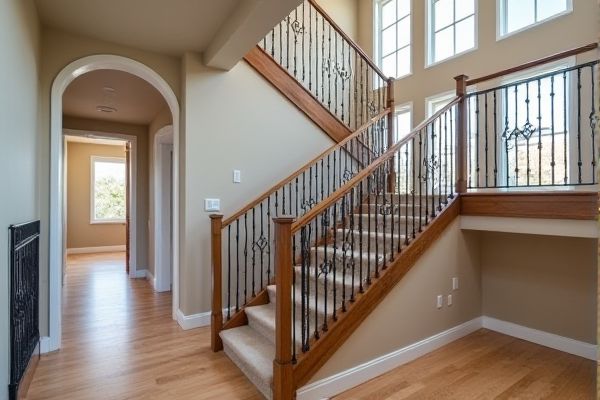
Wrought iron railings offer exceptional durability and ornate designs, while aluminum railings provide lightweight, rust-resistant, and low-maintenance solutions for your outdoor or indoor spaces. Discover the key differences and benefits of each material to make the best choice for your railing needs in the following article.
Table of Comparison
| Feature | Wrought Iron Railing | Aluminum Railing |
|---|---|---|
| Material Strength | High strength, durable, heavy | Moderate strength, lightweight |
| Corrosion Resistance | Prone to rust, requires maintenance | Highly resistant to rust and corrosion |
| Maintenance | Needs regular painting and rust prevention | Low maintenance, occasional cleaning |
| Cost | Generally higher initial cost | More affordable, cost-effective |
| Installation | Heavy; requires professional installation | Lightweight; easier and faster to install |
| Appearance | Classic, ornate, traditional | Modern, sleek, versatile styles |
| Longevity | Long-lasting with proper care | Durable, lasts many years without issues |
| Environmental Impact | Uses more energy to produce; recyclable | Eco-friendly; lightweight reduces transportation carbon footprint |
Introduction to Wrought Iron and Aluminum Railings
Wrought iron railings are renowned for their durability, strength, and classic ornamental designs, often used in traditional and historic architecture to provide both security and aesthetic appeal. Aluminum railings offer a lightweight, corrosion-resistant alternative that requires minimal maintenance, making them ideal for modern and coastal environments where weather resistance is crucial. Both materials provide distinct advantages, with wrought iron emphasizing timeless elegance and aluminum prioritizing functionality and longevity.
Material Composition and Properties
Wrought iron railing is composed primarily of iron with very low carbon content, offering exceptional strength, durability, and resistance to deformation. Aluminum railing consists of a lightweight, corrosion-resistant metal alloy that requires minimal maintenance and provides flexibility in design. Your choice between wrought iron and aluminum railing impacts the balance between heavy-duty strength and ease of upkeep based on these distinct material properties.
Aesthetic Appeal and Design Options
Wrought iron railings offer intricate, classic designs with a heavy, durable look that suits traditional and vintage aesthetics, while aluminum railings provide sleek, modern styles with greater flexibility in shapes and colors due to their lightweight nature. Aluminum's corrosion resistance allows vibrant powder-coated finishes, expanding design possibilities for contemporary settings. Wrought iron's ability to be custom forged into elaborate patterns enhances its appeal for decorative, ornamental railings, contrasting with aluminum's streamlined, minimalist appearance.
Durability and Longevity
Wrought iron railings offer exceptional durability due to their dense composition and resistance to impact, making them ideal for long-term outdoor use with proper maintenance to prevent rust. Aluminum railings provide excellent corrosion resistance and require minimal maintenance, ensuring a long lifespan even in harsh weather conditions, though they may be less resistant to physical damage compared to wrought iron. Choosing between wrought iron and aluminum railings depends on the balance between desired strength and ease of upkeep in specific environmental settings.
Maintenance Requirements
Wrought iron railings require regular maintenance including rust prevention treatments, repainting, and occasional repairs to prevent corrosion and maintain structural integrity. Aluminum railings are low-maintenance, resistant to rust and corrosion, and typically need only periodic cleaning to preserve their appearance. Choosing aluminum reduces upkeep costs and effort compared to the intensive care wrought iron demands.
Cost Comparison: Upfront and Long-Term
Wrought iron railings have a higher upfront cost, typically ranging between $25 to $50 per linear foot, due to their durability and intricate craftsmanship. Aluminum railings are more budget-friendly initially, costing approximately $20 to $30 per linear foot, and offer lower maintenance expenses over time since they resist rust and corrosion. Long-term, aluminum railings tend to be more cost-effective as they require fewer repairs and repainting, whereas wrought iron may incur additional maintenance costs to prevent rust and preserve appearance.
Installation Process and Complexity
Wrought iron railings require a more intensive installation process due to their heavier weight and need for precise anchoring, often involving welding or bolting to ensure stability. Aluminum railings are lighter and come with prefabricated components that simplify installation, allowing for quicker assembly with basic tools. The complexity of wrought iron installation demands skilled labor and more time, while aluminum offers a user-friendly option suitable for DIY projects and faster completion.
Safety and Security Features
Wrought iron railings offer superior safety and security due to their strength, durability, and resistance to impact, providing a robust barrier against intruders and accidental falls. Aluminum railings, while lighter and corrosion-resistant, generally provide less impact resistance but are designed with modern safety standards such as non-toxic coatings and secure mounting systems. Both materials meet building codes, but wrought iron is preferred for high-security applications because of its heavier gauge and ability to withstand forceful entry attempts.
Environmental Impact and Sustainability
Wrought iron railings have a higher environmental impact due to energy-intensive mining and smelting processes, producing substantial carbon emissions. Aluminum railings offer greater sustainability by being lightweight, highly recyclable, and requiring less energy to produce and maintain. Choosing aluminum for your railing supports eco-friendly construction by reducing waste and conserving natural resources.
Choosing the Right Railing for Your Needs
Wrought iron railings offer exceptional strength, durability, and intricate designs, making them ideal for homeowners seeking a classic, long-lasting aesthetic with high security. Aluminum railings provide a lightweight, corrosion-resistant alternative that requires minimal maintenance, perfect for coastal environments or modern designs emphasizing sleekness and ease of installation. Evaluating factors such as budget, climate, maintenance preferences, and style will help determine whether the robust nature of wrought iron or the versatility of aluminum best suits your specific railing needs.
 homyna.com
homyna.com